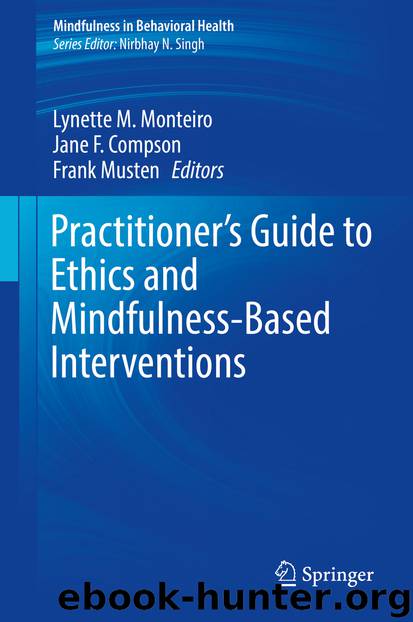Practitioner's Guide to Ethics and Mindfulness-Based Interventions by Lynette M. Monteiro Jane F. Compson & Frank Musten

Author:Lynette M. Monteiro, Jane F. Compson & Frank Musten
Language: eng
Format: epub
Publisher: Springer International Publishing, Cham
Psychological Roots
Convergence of Concepts
In developing MBSM, we were informed by three psychotherapeutic theories and approaches, some of which echoed Buddhist thought: Cognitive Behavioral Therapy (CBT) with its emphasis on examining and challenging negative mind states resonates philosophically with both Buddhism and the Greek Stoics (Tirch, Silberstein, & Kolts, 2016); somatic awareness therapies (Levine, 1997) invite cultivation of awareness of body-mind in tune with the Satipaṭṭhāna and Ānāpānasati suttas; and the Polyvagal Theory (Porges, 2007, 2011), as a physiological theory, contributes significantly to understanding the issues of emotional dysregulation and reactivity. A detailed exploration of each modality is beyond the scope of this chapter; thus, we take a conceptual approach below to the way psychological concepts have informed MBSM and indicate the overlap with Buddhist concepts.
Underlying the approaches from different psychological lineages is the interplay of three Western psychological concepts (Monteiro, 2015): identity, emotion regulation, and stress. In Western psychology, the concept of self contains a sense of agency and the presence of an agent, a doer of deeds, thinker of thoughts (Baumeister, 1999, 2011). In contrast, Buddhist thought differs and holds the view that there is no agent, no lasting, substantive “self,” although Tuske (2013) notes this concept is not without its difficulties. Buddhist and Western psychology, however, share an overlapping idea of a constantly changing perception of who we are based on cultural, emotional, and situational influences, that is, an emergent and embodied self (Varela, Thompson, & Rosch, 2017). Cognitive theories and therapies (Beck, Rush, Shaw, & Emery, 1987; Riso, du Toit, Stein, & Young, 2007) view identity as schemas or aggregates of characteristics, relationships with others, and aspirations in the world. A schema can be challenged by lived experiences especially if the schema holds or is close to an aspect of self that is valued. Traditionally, psychological distress is viewed as our response to these challenges, typically framed as a response to a threat to self-constructs (R. S. Lazarus & Folkman, 1984).
Emotion regulation and the role of mindfulness training is perhaps the central focus of contemplative approaches in psychology and thus occupy a larger space for discussion here. Holzel et al. (2011) outlined a set of mechanisms that interact to produce self-regulation and Roeser et al. (2014) described the intricate research connecting emotion regulation and sensory perception in developing ethical action. Emotions, while not specified in the Buddhist view, are linked to sensations, ephemeral arisings from the process of contact with the world and one’s interpretation of that experience. From the Western perspective, Ekman and Davidson (1994) conceptualized emotions as arising from a confluence of cognitive, behavioral, and physiological responses to an external or internal event. R. S. Lazarus and Folkman (1984) proposed that cognitive appraisal of an event activates the stress response system. A. Lazarus (1989, 2006) placed emotions (affect) as part of a multimodal determination of experience involving behavior, affect (emotion), sensations, imagery, and cognition (BASIC) . Emotion regulation is central in Western psychological theories of psychotherapy and is often one of the core intentions in psychotherapy.
Download
This site does not store any files on its server. We only index and link to content provided by other sites. Please contact the content providers to delete copyright contents if any and email us, we'll remove relevant links or contents immediately.
Inner Engineering: A Yogi's Guide to Joy by Sadhguru(6752)
The Power of Now: A Guide to Spiritual Enlightenment by Eckhart Tolle(5679)
Fear by Osho(4698)
Ikigai by Héctor García & Francesc Miralles(4173)
The Art of Happiness by The Dalai Lama(4090)
The Ultimate Bodybuilding Cookbook by Kendall Lou Schmidt(3906)
Yoga Therapy by Mark Stephens(3721)
The Little Book of Hygge by Meik Wiking(3659)
The Healing Self by Deepak Chopra(3525)
Why Buddhism is True by Robert Wright(3423)
The Hatha Yoga Pradipika (Translated) by Svatmarama(3281)
Being Aware of Being Aware by Rupert Spira(3247)
Shift into Freedom by Loch Kelly(3165)
Wild Words from Wild Women by Stephens Autumn(3115)
Work Clean by Dan Charnas(3080)
Happiness by Matthieu Ricard(3020)
More Language of Letting Go: 366 New Daily Meditations by Melody Beattie(3002)
Yoga Body & Mind Handbook by Jasmine Tarkeshi(2850)
Why I Am Not a Feminist by Jessa Crispin(2724)
